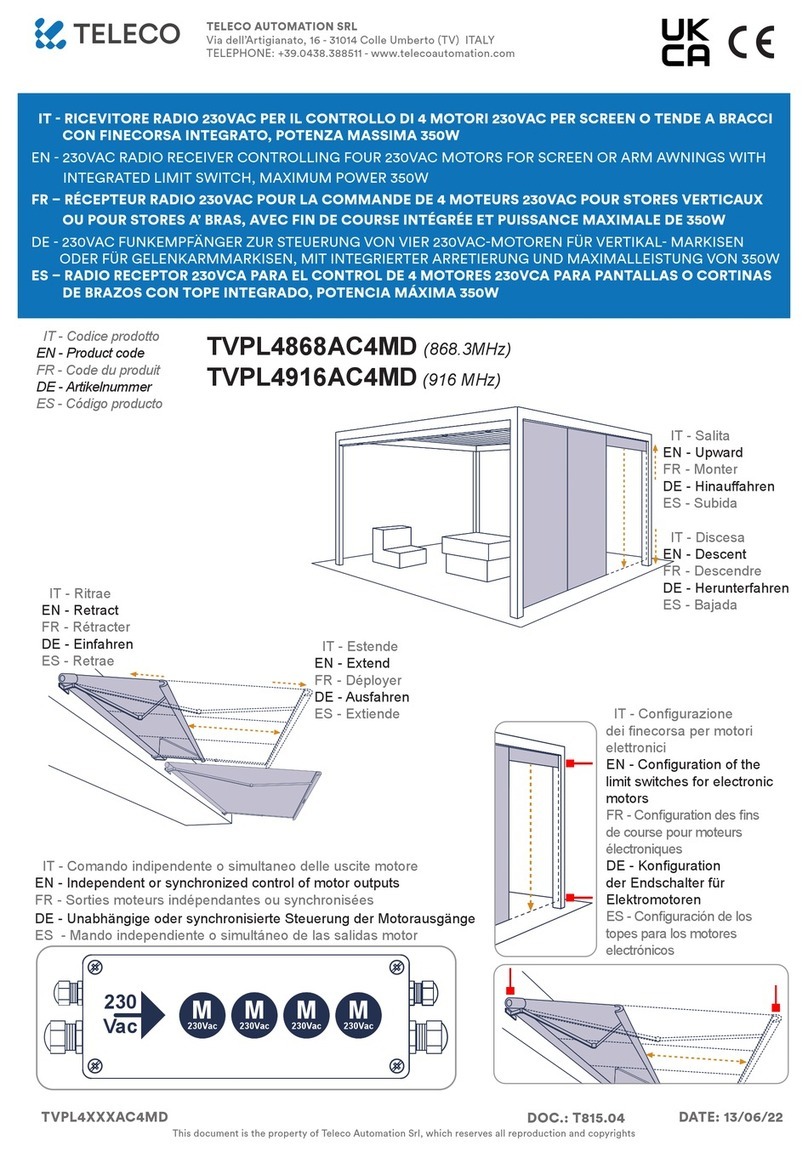
PROGRAMMING START:
Once the transmitters have been memorised the functions are as follows:
Transmitter TVTXV868A02: Channel 1: opening
Channel 2: closing
Transmitter TVTXV868A04: Channel 1: opening
Channel 2: closing
Channel 3: opening
Channel 4: closing
Program each shutter one at a time !!
Power up the rst shutter and carry out programming then proceed with the other shutters one at a time. Once all the shutters have been programmed turn on the
power to the entire system. If all receivers are powered and the memory is empty, they will register all codes sent by the transmitters and it will be impossible to
program the commands individually.
The function of the transmitters is as follows:
Pressing a command button will rotate the motor in the
desired direction. To stop the motor in an intermediate
position press the button which corresponds to the opposite
sense of rotation. For example: during the opening stage,
press the closing button to stop the motor. Press the opening
or closing button to close or open the shutters.
PRESS IN
PRESS IN
PULL UP
PULL UP
A/ Open the transmitter
C/ Press C1
BiiiiiiiiiiiiiiiiiiiiiiiiiiiiiiiiP
(5 sec.máx )
B/ Press P3
BiP, BiP, BiP, BiP, BiP, BiP
DURING THIS STAGE ONLY POWER UP THE FIRST SHUTTER!!
If there is more than one shutter in the installation you will have to connect them
one by one and program the relative transmitter individually (see bottom of the
page).
The receiver will sound a Beep for a maximum of 5 seconds. Pass to stage C before
the 5 seconds has expired. If the receiver has stopped beeping, repeat this stage.
The receiver will sound several rapid Beeps to conrm that channel 1 has been
memorised.
CHANNEL 1 HAS BEEN MEMORISED.
THE TRANSMITTER HAS NOW BECOME THE MAIN TRANSMITTER AND
CAN BE USED TO MEMORISE OTHER CHANNELS FOR THIS SHUTTER.
FOR SUCCESSIVE SHUTTERS
- POWER UP THE NEXT SHUTTER;
- CARRY OUT STAGES A TO F WITH THE SUCCESSIVE SHUTTERS;
- PROCEED IN THIS WAY WITH ALL SUCCESSIVE SHUTTERS;
- IN THIS WAY EACH SHUTTER HAS MEMORISED ITS OWN INDIVIDUAL TRANSMITTER.
You must keep the transmitter button pressed for at least 2 seconds to give the receiver time to decode the signal it is receiving.
PROGRAMMING THE FIRST INDIVIDUAL TRANSMITTER (EMPTY RECEIVER)
New
transmitter
New
transmitter
2
ShutterA
ShutterB
ShutterC
ShutterD
TX A
Direct programming
TX E
Programming E + A
(see page 2)
TX individual
TX Ulterior individual
TX G
Programming G + A; G + B; G + C; G + D
(see page 2)
TX g eneral command
TX F
Programming
F + C; F + D (see page 2)
TX Subgroup
TX B
Direct programming
TX C
Direct programming
TX D
Direct programming
Before starting programming and in order to
avoid making mistakes it is necessary that you are
familiar with the logic that the receivers use to
memorise the channels.
Installation example for four shutters
In this stage
-Power up the shutter A is to be programmed.
-Disconnect shutter A.
-Power up shutter B, etc...
When programming ulterior transmitters it is possible to
the system powered up (as long as the shutters already
have an individually programmed main transmitter).
It is also possible to program shutter for shutter while you
are programming individual transmitters.
Power up the shutters one at a time during the program
stages for each individual transmitter (from A to D).
If all the receivers are powered up they will all memori-
se the same signal during programming. It will then be
impossible to individually select the shutters.
PROGRAMMING METHOD






















